Unit 10 I'd like some noodles. 教案 (5课时)2023-2024学年人教版七年级英语下册
文档属性
| 名称 | Unit 10 I'd like some noodles. 教案 (5课时)2023-2024学年人教版七年级英语下册 | 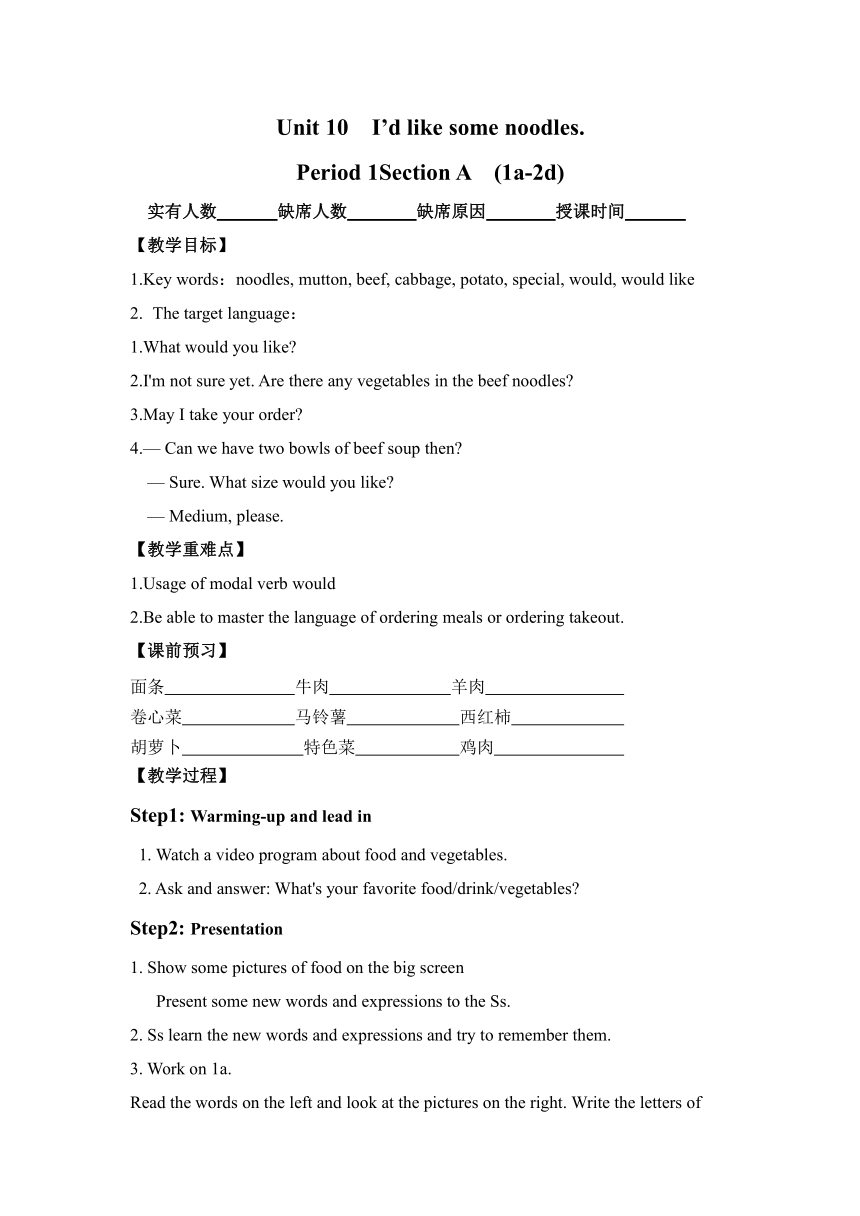 | |
| 格式 | docx | ||
| 文件大小 | 31.7KB | ||
| 资源类型 | 教案 | ||
| 版本资源 | 人教新目标(Go for it)版 | ||
| 科目 | 英语 | ||
| 更新时间 | 2024-06-17 16:18:11 | ||
图片预览

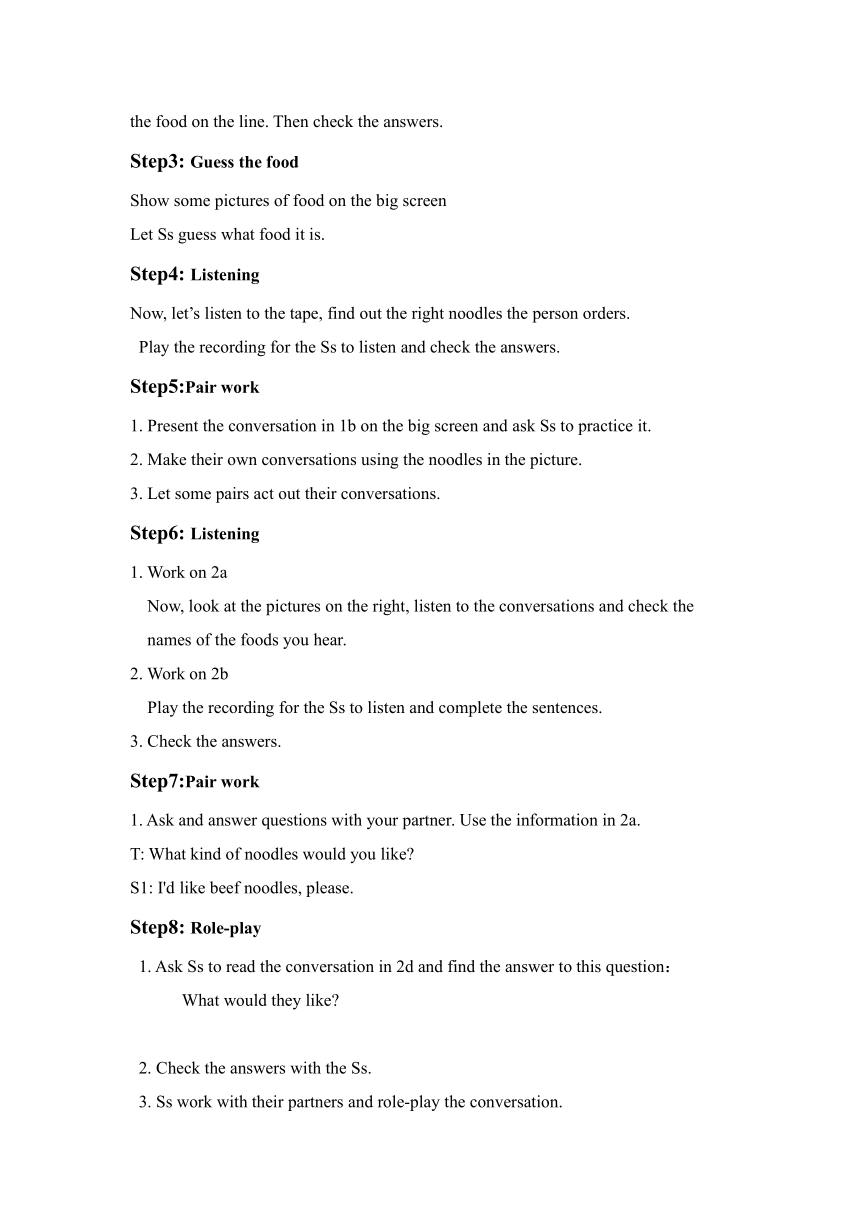
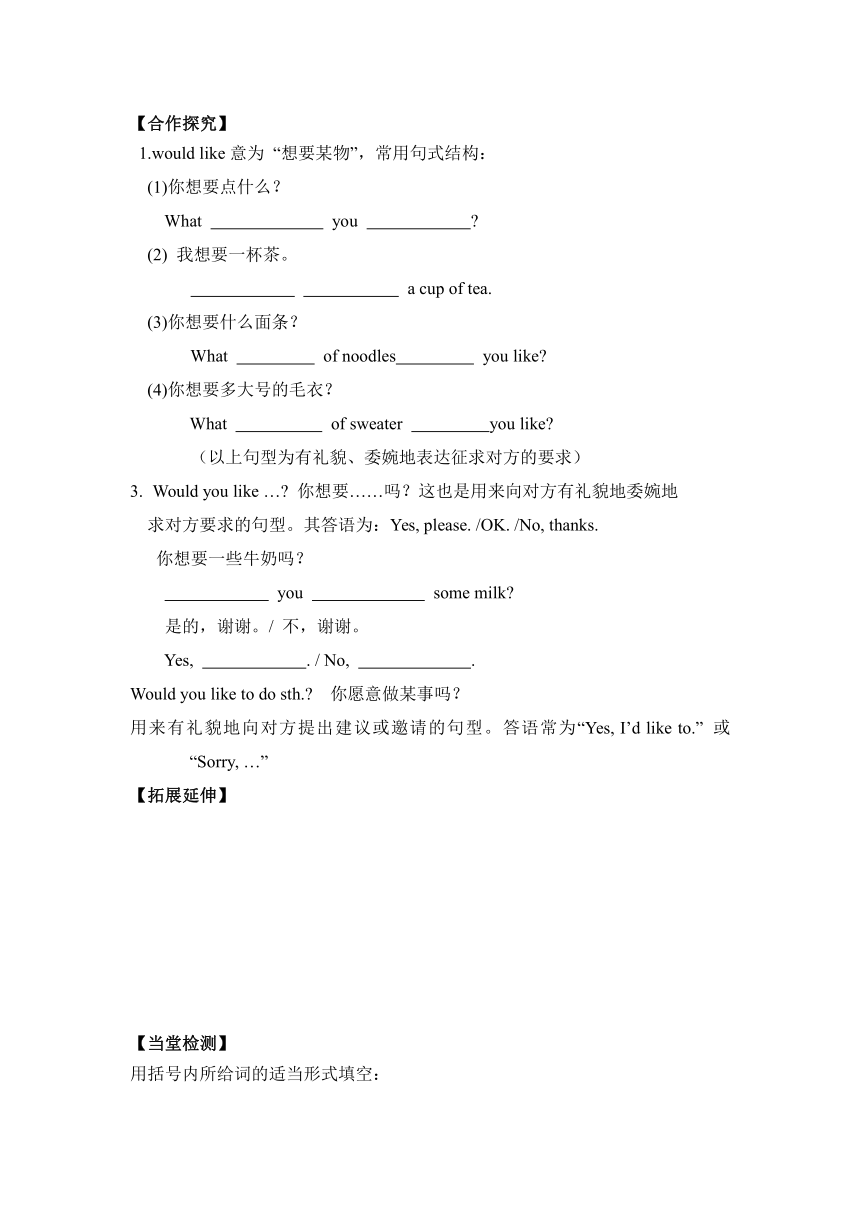
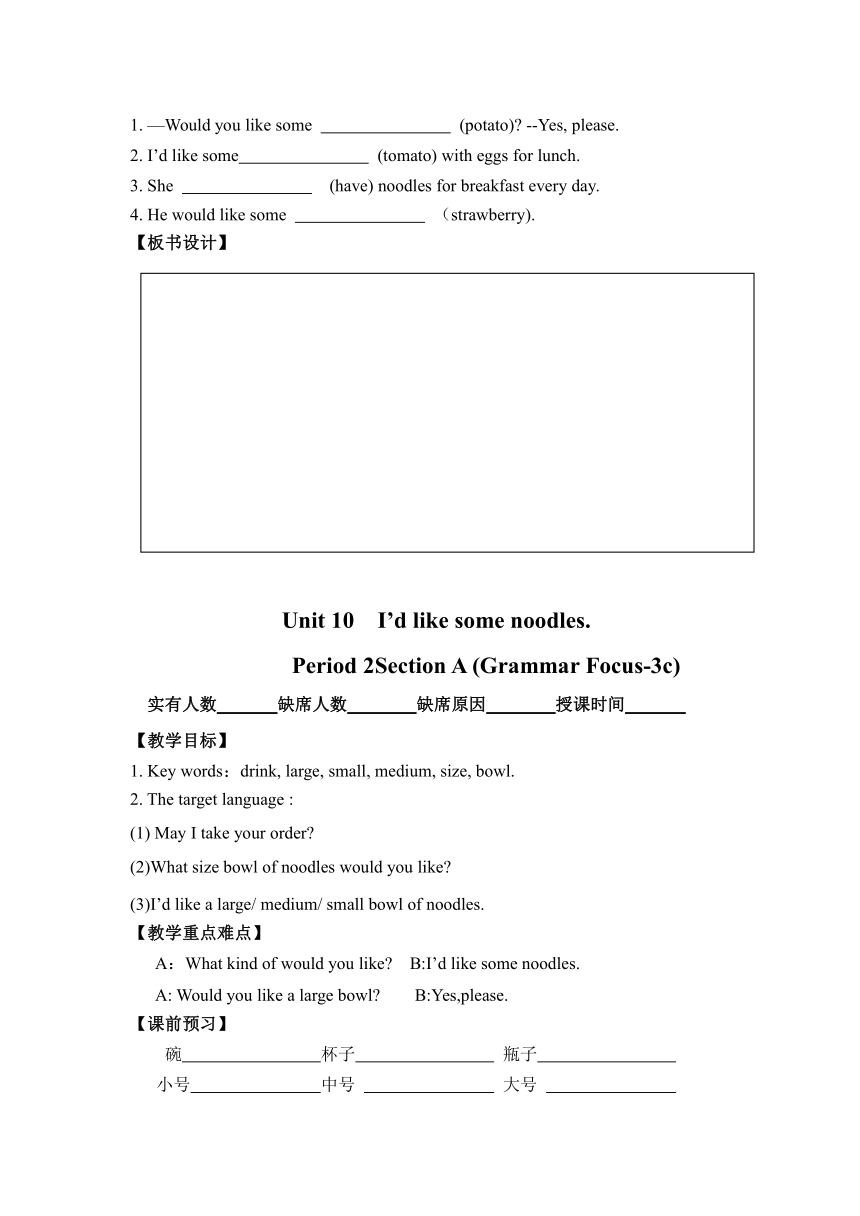
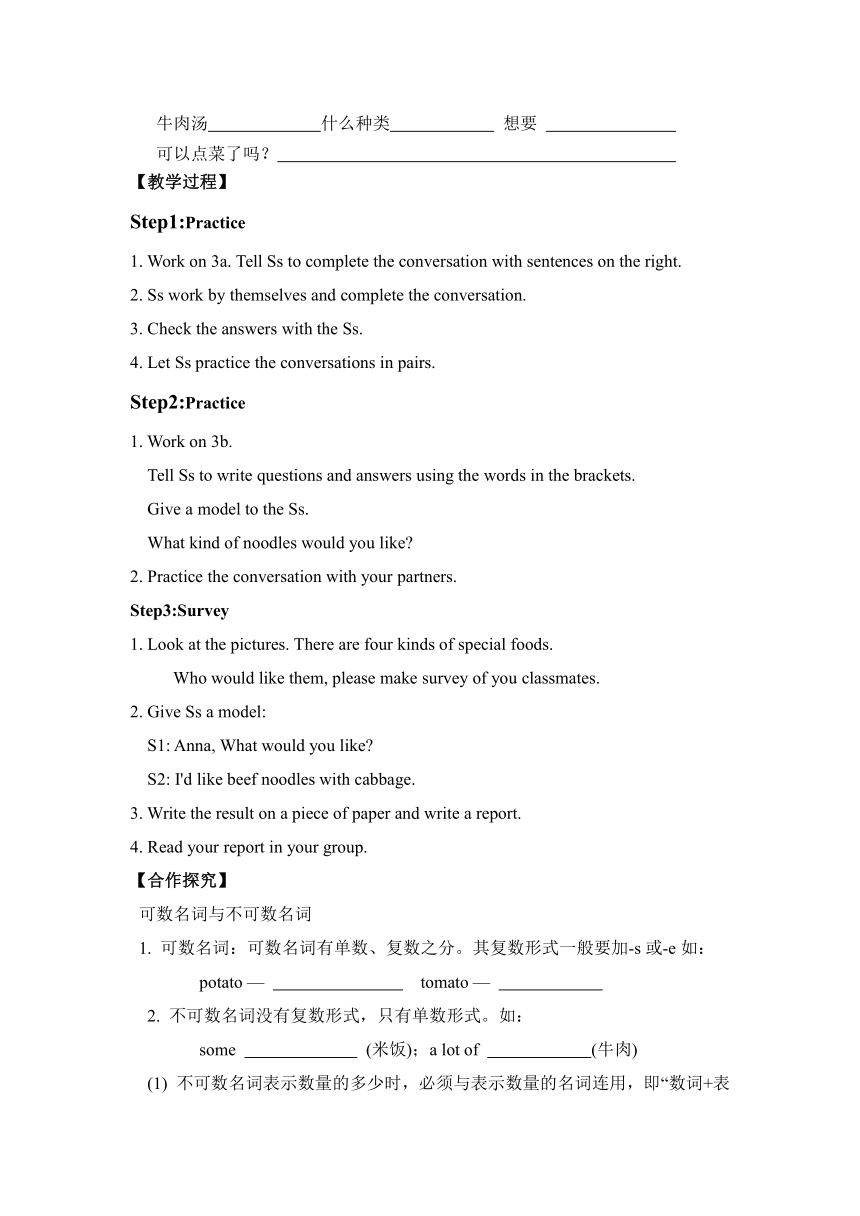
文档简介
Unit 10 I’d like some noodles.
Period 1Section A (1a-2d)
实有人数 缺席人数 缺席原因 授课时间
【教学目标】
1.Key words:noodles, mutton, beef, cabbage, potato, special, would, would like
The target language:
1.What would you like
2.I'm not sure yet. Are there any vegetables in the beef noodles
3.May I take your order
4.— Can we have two bowls of beef soup then
— Sure. What size would you like
— Medium, please.
【教学重难点】
1.Usage of modal verb would
2.Be able to master the language of ordering meals or ordering takeout.
【课前预习】
面条 牛肉 羊肉
卷心菜 马铃薯 西红柿
胡萝卜 特色菜 鸡肉
【教学过程】
Step1: Warming-up and lead in
1. Watch a video program about food and vegetables.
2. Ask and answer: What's your favorite food/drink/vegetables
Step2: Presentation
1. Show some pictures of food on the big screen
Present some new words and expressions to the Ss.
2. Ss learn the new words and expressions and try to remember them.
3. Work on 1a.
Read the words on the left and look at the pictures on the right. Write the letters of
the food on the line. Then check the answers.
Step3: Guess the food
Show some pictures of food on the big screen
Let Ss guess what food it is.
Step4: Listening
Now, let’s listen to the tape, find out the right noodles the person orders.
Play the recording for the Ss to listen and check the answers.
Step5:Pair work
1. Present the conversation in 1b on the big screen and ask Ss to practice it.
2. Make their own conversations using the noodles in the picture.
3. Let some pairs act out their conversations.
Step6: Listening
1. Work on 2a
Now, look at the pictures on the right, listen to the conversations and check the
names of the foods you hear.
2. Work on 2b
Play the recording for the Ss to listen and complete the sentences.
3. Check the answers.
Step7:Pair work
1. Ask and answer questions with your partner. Use the information in 2a.
T: What kind of noodles would you like
S1: I'd like beef noodles, please.
Step8: Role-play
1. Ask Ss to read the conversation in 2d and find the answer to this question:
What would they like
2. Check the answers with the Ss.
3. Ss work with their partners and role-play the conversation.
【合作探究】
1.would like意为 “想要某物”,常用句式结构:
(1)你想要点什么?
What you
(2) 我想要一杯茶。
a cup of tea.
(3)你想要什么面条?
What of noodles you like
(4)你想要多大号的毛衣?
What of sweater you like
(以上句型为有礼貌、委婉地表达征求对方的要求)
Would you like … 你想要……吗?这也是用来向对方有礼貌地委婉地
求对方要求的句型。其答语为:Yes, please. /OK. /No, thanks.
你想要一些牛奶吗?
you some milk
是的,谢谢。/ 不,谢谢。
Yes, . / No, .
Would you like to do sth. 你愿意做某事吗?
用来有礼貌地向对方提出建议或邀请的句型。答语常为“Yes, I’d like to.” 或“Sorry, …”
【拓展延伸】
【当堂检测】
用括号内所给词的适当形式填空:
1. —Would you like some (potato) --Yes, please.
2. I’d like some (tomato) with eggs for lunch.
3. She (have) noodles for breakfast every day.
4. He would like some (strawberry).
【板书设计】
Unit 10 I’d like some noodles.
Period 2Section A (Grammar Focus-3c)
实有人数 缺席人数 缺席原因 授课时间
【教学目标】
1. Key words:drink, large, small, medium, size, bowl.
2. The target language :
(1) May I take your order
(2)What size bowl of noodles would you like
(3)I’d like a large/ medium/ small bowl of noodles.
【教学重点难点】
A:What kind of would you like B:I’d like some noodles.
A: Would you like a large bowl B:Yes,please.
【课前预习】
碗 杯子 瓶子
小号 中号 大号
牛肉汤 什么种类 想要
可以点菜了吗?
【教学过程】
Step1:Practice
1. Work on 3a. Tell Ss to complete the conversation with sentences on the right.
2. Ss work by themselves and complete the conversation.
3. Check the answers with the Ss.
4. Let Ss practice the conversations in pairs.
Step2:Practice
1. Work on 3b.
Tell Ss to write questions and answers using the words in the brackets.
Give a model to the Ss.
What kind of noodles would you like
2. Practice the conversation with your partners.
Step3:Survey
1. Look at the pictures. There are four kinds of special foods.
Who would like them, please make survey of you classmates.
2. Give Ss a model:
S1: Anna, What would you like
S2: I'd like beef noodles with cabbage.
3. Write the result on a piece of paper and write a report.
4. Read your report in your group.
【合作探究】
可数名词与不可数名词
1. 可数名词:可数名词有单数、复数之分。其复数形式一般要加-s或-e如:
potato — tomato —
2. 不可数名词没有复数形式,只有单数形式。如:
some (米饭);a lot of (牛肉)
(1) 不可数名词表示数量的多少时,必须与表示数量的名词连用,即“数词+表示数量的名词(可数名词)+ of + 不可数名词”,如:
两玻璃杯果汁 of juice
三碗米饭 of rice
(2) 不可数名词做主语时,谓语动词只能用单数形式。例如:
在碗里有一些羊肉汤。
There mutton soup in the bowl.
如果不可数名词前有复数名词短语修饰时,谓语动词须用复数形式。如:
房间里有两袋子大米。
two bags of rice in the room.
【拓展延伸】
【当堂检测】
1.早餐你想吃什么?
__________ _________ you __________ ___________ breakfast
2. 他想要哪种类型的面条?
kind of noodles he like
3. 你想要几码的鞋?
shoes you
【板书设计】
(
)
Unit 10 I’d like some noodles.
Period 3 Section B (1a-1e)
实有人数 缺席人数 缺席原因 授课时间
【教学目标】
1.Key words:dumpling porridge onion fish pancake
2.The target language:
(1) What kind of dumplings would you like
(2) I don’t like onions, green tea or porridge.
(3) I like dumplings, fish and orange juice.
【教学重难点】
The usage of sentence pattern “Would you like... ”
【课前预习】
水饺 绿茶 洋葱
粥 橘 汁 烙 饼
【教学过程】
Step1: Warming- up
Let’s watch a video and learn.
Step2: Presentation
1. Show some pictures of food on the big screen
Present some new words and expressions to the Ss.
2. Ss learn the new words and expressions and try to remember them.
3. Work on 1a
Read the words in the chart and look at the pictures below. Write the letters of the foods or drinks on the line. Then check the answers.
Step4: Pairwork
1. Work in groups. Talk about what you like and what you don’t like.
2.Make a list of things every one likes and dislikes in your group. Then give a report to your classmates:
3. Let some Ss give their report.
Step5:Listening
Work on 1c
1. Ask Ss to read the ORDER FORM carefully.
2. Play the tape for the Ss to listen and complete the food order form.
Work on 1d:
Listen again. Use the pause button to check the answers with the Ss.
Step6:Group work
1. Work in groups. Discuss what do you do or eat on your birthday
【合作探究】
1.fish 鱼,鱼肉
(1) 意为“鱼”,是可数名词,单复数同形。fish 也可加es, 指不同种类的鱼。
eg: I have three fish at home.
There are many fishes in the sea. 大海里有各种各样的鱼。
(2) 意为“鱼肉”,是不可数名词。
eg: I eat fish for dinner every day.
(3) 意为“钓鱼”,是动词,常用于短语go fishing .“去钓鱼”。
2.Would like +sth 想要某物
Would like +to do sth 想要做某事
【拓展延伸】
【当堂测试】
一、用所给单词的适当形式填空。
1、I’d like (order) a large bowl of beef noodles.
2、A large bowl of noodles (be) not enough.
3、I’d like some (tomato) and (onion).
4、They would like (potato) noodles.
二、根据汉语意思完成句子。
1、他不喜欢绿茶和橙汁。
He like green tea orange juice.
2、你想要牛肉、鱼肉还是羊肉?
Would you beef, fish mutton
3、你想喝碗粥吗?
Do you want to have a of
【板书设计】
Unit 10 I’d like some noodles.
Period 4 Section B (2a-2d)
实有人数 缺席人数 缺席原因 授课时间
【教学目标】
Key words:world answer different candle age blow if will
the UK candy lucky popular idea
The target language:
1.The answer would be different in different countries.
2.The number of candles is the person's age.
3.In China, it's getting popular
【课前预习】
答案 不同的__________ 蛋糕 蜡烛
年龄 许愿 吹灭 糖果___________
幸运的____________ 受欢迎;流行 切碎_____________
【教学过程】
Step1: Read 2b and translate these phrases
蜡烛的数目 一口气 ____________ 在英国
长寿面 长寿的象征
给……带来好运__________________ 与……不同
Step2: Read again and finish 2c
Step3: Read quickly and answer the questions
1、What would people like to eat on their birthday
___________________________________________________________
2、What is the number of candles in many countries
___________________________________________________________
3、What do many people eat for their birthday in China
___________________________________________________________
4、What do people sometimes put in a birthday cake in the UK
___________________________________________________________
【合作探究】
1、The number of candles is the person’s age.
the number of 意为“……的数量”,后跟名词复数,作主语时,谓语动词用单数。
eg: The number of students in the room is 50.
拓展:a number of… “许多……”,后跟复数名词,作主语时,谓语动词用复数。
eg: A number of students are playing basketball.
2、If he or she blows out all the candles in one go,the wish will come true.
if 引导的条件状语从句,主句用一般将来时,从句用一般现在时。
eg: If it rains tomorrow, we will not go to the zoo.
3、In China, it is getting popular to have cake on your birthday.
在中国,在生日时吃蛋糕正变得流行。
句中it为形式主语,真正的主语是其后的动词不定式短语。
eg: It is not easy to finish the work in two days.
【拓展延伸】
【当堂测试】
一、用所给单词的适当形式填空。
1、He will go to the park if he_________(be) free tomorrow.
2、The child with the candy is_________(luck).
3、I’d like__________(go) to the beach on weekends.
4、The Pizza House has some great _________(special).
5、There are shoes of all _________(size) in the supermarket.
【板书设计】
Period 5 Section B (3a –3c)
班级人数 缺席人数 原因
Unit 10 I’d like some noodles.
Period 5 Section B (3a-Self Check)
实有人数 缺席人数 缺席原因 授课时间
【教学目标】
Key words and phrases:order,bowl,kinds,specials,different kinds of,would like.
2.Key sentences:
1.We have … for …
2.You can try our …
3.… is very good/delicious.
4.Would you like …
【教学重难点】
Through the training of writing, students can really use the knowledge they have learned in practical activities.
【写作要求】
中心大街新开了一家格林面馆,面馆主要经营各类面条,有牛肉面、羊肉面、鸡蛋面还有蔬菜面。其中,牛肉面是他们的特色。大碗牛肉面12元,中碗10元,小碗8元。在周末所有面条特价。欢迎光临。
请根据上述情况给格林面馆写-则 70词左右的广告。
思路分析
1.第一部分:开篇点题,引人面馆这一话题→Welcome to.... find all kinds of...
2.第二部分:介绍面馆的面条→We have..noodles,great special, A large bowl of...
A medium bowl is.... small bowl .... On weekends,all the noodles are on sale.
3.第三部分:发出邀请→Come and have..
Green Noodle House
【教学反思】
Period 1Section A (1a-2d)
实有人数 缺席人数 缺席原因 授课时间
【教学目标】
1.Key words:noodles, mutton, beef, cabbage, potato, special, would, would like
The target language:
1.What would you like
2.I'm not sure yet. Are there any vegetables in the beef noodles
3.May I take your order
4.— Can we have two bowls of beef soup then
— Sure. What size would you like
— Medium, please.
【教学重难点】
1.Usage of modal verb would
2.Be able to master the language of ordering meals or ordering takeout.
【课前预习】
面条 牛肉 羊肉
卷心菜 马铃薯 西红柿
胡萝卜 特色菜 鸡肉
【教学过程】
Step1: Warming-up and lead in
1. Watch a video program about food and vegetables.
2. Ask and answer: What's your favorite food/drink/vegetables
Step2: Presentation
1. Show some pictures of food on the big screen
Present some new words and expressions to the Ss.
2. Ss learn the new words and expressions and try to remember them.
3. Work on 1a.
Read the words on the left and look at the pictures on the right. Write the letters of
the food on the line. Then check the answers.
Step3: Guess the food
Show some pictures of food on the big screen
Let Ss guess what food it is.
Step4: Listening
Now, let’s listen to the tape, find out the right noodles the person orders.
Play the recording for the Ss to listen and check the answers.
Step5:Pair work
1. Present the conversation in 1b on the big screen and ask Ss to practice it.
2. Make their own conversations using the noodles in the picture.
3. Let some pairs act out their conversations.
Step6: Listening
1. Work on 2a
Now, look at the pictures on the right, listen to the conversations and check the
names of the foods you hear.
2. Work on 2b
Play the recording for the Ss to listen and complete the sentences.
3. Check the answers.
Step7:Pair work
1. Ask and answer questions with your partner. Use the information in 2a.
T: What kind of noodles would you like
S1: I'd like beef noodles, please.
Step8: Role-play
1. Ask Ss to read the conversation in 2d and find the answer to this question:
What would they like
2. Check the answers with the Ss.
3. Ss work with their partners and role-play the conversation.
【合作探究】
1.would like意为 “想要某物”,常用句式结构:
(1)你想要点什么?
What you
(2) 我想要一杯茶。
a cup of tea.
(3)你想要什么面条?
What of noodles you like
(4)你想要多大号的毛衣?
What of sweater you like
(以上句型为有礼貌、委婉地表达征求对方的要求)
Would you like … 你想要……吗?这也是用来向对方有礼貌地委婉地
求对方要求的句型。其答语为:Yes, please. /OK. /No, thanks.
你想要一些牛奶吗?
you some milk
是的,谢谢。/ 不,谢谢。
Yes, . / No, .
Would you like to do sth. 你愿意做某事吗?
用来有礼貌地向对方提出建议或邀请的句型。答语常为“Yes, I’d like to.” 或“Sorry, …”
【拓展延伸】
【当堂检测】
用括号内所给词的适当形式填空:
1. —Would you like some (potato) --Yes, please.
2. I’d like some (tomato) with eggs for lunch.
3. She (have) noodles for breakfast every day.
4. He would like some (strawberry).
【板书设计】
Unit 10 I’d like some noodles.
Period 2Section A (Grammar Focus-3c)
实有人数 缺席人数 缺席原因 授课时间
【教学目标】
1. Key words:drink, large, small, medium, size, bowl.
2. The target language :
(1) May I take your order
(2)What size bowl of noodles would you like
(3)I’d like a large/ medium/ small bowl of noodles.
【教学重点难点】
A:What kind of would you like B:I’d like some noodles.
A: Would you like a large bowl B:Yes,please.
【课前预习】
碗 杯子 瓶子
小号 中号 大号
牛肉汤 什么种类 想要
可以点菜了吗?
【教学过程】
Step1:Practice
1. Work on 3a. Tell Ss to complete the conversation with sentences on the right.
2. Ss work by themselves and complete the conversation.
3. Check the answers with the Ss.
4. Let Ss practice the conversations in pairs.
Step2:Practice
1. Work on 3b.
Tell Ss to write questions and answers using the words in the brackets.
Give a model to the Ss.
What kind of noodles would you like
2. Practice the conversation with your partners.
Step3:Survey
1. Look at the pictures. There are four kinds of special foods.
Who would like them, please make survey of you classmates.
2. Give Ss a model:
S1: Anna, What would you like
S2: I'd like beef noodles with cabbage.
3. Write the result on a piece of paper and write a report.
4. Read your report in your group.
【合作探究】
可数名词与不可数名词
1. 可数名词:可数名词有单数、复数之分。其复数形式一般要加-s或-e如:
potato — tomato —
2. 不可数名词没有复数形式,只有单数形式。如:
some (米饭);a lot of (牛肉)
(1) 不可数名词表示数量的多少时,必须与表示数量的名词连用,即“数词+表示数量的名词(可数名词)+ of + 不可数名词”,如:
两玻璃杯果汁 of juice
三碗米饭 of rice
(2) 不可数名词做主语时,谓语动词只能用单数形式。例如:
在碗里有一些羊肉汤。
There mutton soup in the bowl.
如果不可数名词前有复数名词短语修饰时,谓语动词须用复数形式。如:
房间里有两袋子大米。
two bags of rice in the room.
【拓展延伸】
【当堂检测】
1.早餐你想吃什么?
__________ _________ you __________ ___________ breakfast
2. 他想要哪种类型的面条?
kind of noodles he like
3. 你想要几码的鞋?
shoes you
【板书设计】
(
)
Unit 10 I’d like some noodles.
Period 3 Section B (1a-1e)
实有人数 缺席人数 缺席原因 授课时间
【教学目标】
1.Key words:dumpling porridge onion fish pancake
2.The target language:
(1) What kind of dumplings would you like
(2) I don’t like onions, green tea or porridge.
(3) I like dumplings, fish and orange juice.
【教学重难点】
The usage of sentence pattern “Would you like... ”
【课前预习】
水饺 绿茶 洋葱
粥 橘 汁 烙 饼
【教学过程】
Step1: Warming- up
Let’s watch a video and learn.
Step2: Presentation
1. Show some pictures of food on the big screen
Present some new words and expressions to the Ss.
2. Ss learn the new words and expressions and try to remember them.
3. Work on 1a
Read the words in the chart and look at the pictures below. Write the letters of the foods or drinks on the line. Then check the answers.
Step4: Pairwork
1. Work in groups. Talk about what you like and what you don’t like.
2.Make a list of things every one likes and dislikes in your group. Then give a report to your classmates:
3. Let some Ss give their report.
Step5:Listening
Work on 1c
1. Ask Ss to read the ORDER FORM carefully.
2. Play the tape for the Ss to listen and complete the food order form.
Work on 1d:
Listen again. Use the pause button to check the answers with the Ss.
Step6:Group work
1. Work in groups. Discuss what do you do or eat on your birthday
【合作探究】
1.fish 鱼,鱼肉
(1) 意为“鱼”,是可数名词,单复数同形。fish 也可加es, 指不同种类的鱼。
eg: I have three fish at home.
There are many fishes in the sea. 大海里有各种各样的鱼。
(2) 意为“鱼肉”,是不可数名词。
eg: I eat fish for dinner every day.
(3) 意为“钓鱼”,是动词,常用于短语go fishing .“去钓鱼”。
2.Would like +sth 想要某物
Would like +to do sth 想要做某事
【拓展延伸】
【当堂测试】
一、用所给单词的适当形式填空。
1、I’d like (order) a large bowl of beef noodles.
2、A large bowl of noodles (be) not enough.
3、I’d like some (tomato) and (onion).
4、They would like (potato) noodles.
二、根据汉语意思完成句子。
1、他不喜欢绿茶和橙汁。
He like green tea orange juice.
2、你想要牛肉、鱼肉还是羊肉?
Would you beef, fish mutton
3、你想喝碗粥吗?
Do you want to have a of
【板书设计】
Unit 10 I’d like some noodles.
Period 4 Section B (2a-2d)
实有人数 缺席人数 缺席原因 授课时间
【教学目标】
Key words:world answer different candle age blow if will
the UK candy lucky popular idea
The target language:
1.The answer would be different in different countries.
2.The number of candles is the person's age.
3.In China, it's getting popular
【课前预习】
答案 不同的__________ 蛋糕 蜡烛
年龄 许愿 吹灭 糖果___________
幸运的____________ 受欢迎;流行 切碎_____________
【教学过程】
Step1: Read 2b and translate these phrases
蜡烛的数目 一口气 ____________ 在英国
长寿面 长寿的象征
给……带来好运__________________ 与……不同
Step2: Read again and finish 2c
Step3: Read quickly and answer the questions
1、What would people like to eat on their birthday
___________________________________________________________
2、What is the number of candles in many countries
___________________________________________________________
3、What do many people eat for their birthday in China
___________________________________________________________
4、What do people sometimes put in a birthday cake in the UK
___________________________________________________________
【合作探究】
1、The number of candles is the person’s age.
the number of 意为“……的数量”,后跟名词复数,作主语时,谓语动词用单数。
eg: The number of students in the room is 50.
拓展:a number of… “许多……”,后跟复数名词,作主语时,谓语动词用复数。
eg: A number of students are playing basketball.
2、If he or she blows out all the candles in one go,the wish will come true.
if 引导的条件状语从句,主句用一般将来时,从句用一般现在时。
eg: If it rains tomorrow, we will not go to the zoo.
3、In China, it is getting popular to have cake on your birthday.
在中国,在生日时吃蛋糕正变得流行。
句中it为形式主语,真正的主语是其后的动词不定式短语。
eg: It is not easy to finish the work in two days.
【拓展延伸】
【当堂测试】
一、用所给单词的适当形式填空。
1、He will go to the park if he_________(be) free tomorrow.
2、The child with the candy is_________(luck).
3、I’d like__________(go) to the beach on weekends.
4、The Pizza House has some great _________(special).
5、There are shoes of all _________(size) in the supermarket.
【板书设计】
Period 5 Section B (3a –3c)
班级人数 缺席人数 原因
Unit 10 I’d like some noodles.
Period 5 Section B (3a-Self Check)
实有人数 缺席人数 缺席原因 授课时间
【教学目标】
Key words and phrases:order,bowl,kinds,specials,different kinds of,would like.
2.Key sentences:
1.We have … for …
2.You can try our …
3.… is very good/delicious.
4.Would you like …
【教学重难点】
Through the training of writing, students can really use the knowledge they have learned in practical activities.
【写作要求】
中心大街新开了一家格林面馆,面馆主要经营各类面条,有牛肉面、羊肉面、鸡蛋面还有蔬菜面。其中,牛肉面是他们的特色。大碗牛肉面12元,中碗10元,小碗8元。在周末所有面条特价。欢迎光临。
请根据上述情况给格林面馆写-则 70词左右的广告。
思路分析
1.第一部分:开篇点题,引人面馆这一话题→Welcome to.... find all kinds of...
2.第二部分:介绍面馆的面条→We have..noodles,great special, A large bowl of...
A medium bowl is.... small bowl .... On weekends,all the noodles are on sale.
3.第三部分:发出邀请→Come and have..
Green Noodle House
【教学反思】
同课章节目录
- Unit 1 Can you play the guitar?
- Section A
- Section B
- Unit 2 What time do you go to school?
- Section A
- Section B
- Unit 3 How do you get to school?
- Section A
- Section B
- Unit 4 Don't eat in class.
- Section A
- Section B
- Unit 5 Why do you like pandas?
- Section A
- Section B
- Unit 6 I'm watching TV.
- Section A
- Section B
- Review of Units 1-6
- Unit 7 It's raining!
- Section A
- Section B
- Unit 8 Is there a post office near here?
- Section A
- Section B
- Unit 9 What does he look like?
- Section A
- Section B
- Unit 10 I'd like some noodles.
- Section A
- Section B
- Unit 11 How was your school trip?
- Section A
- Section B
- Unit 12 What did you do last weekend?
- Section A
- Section B
